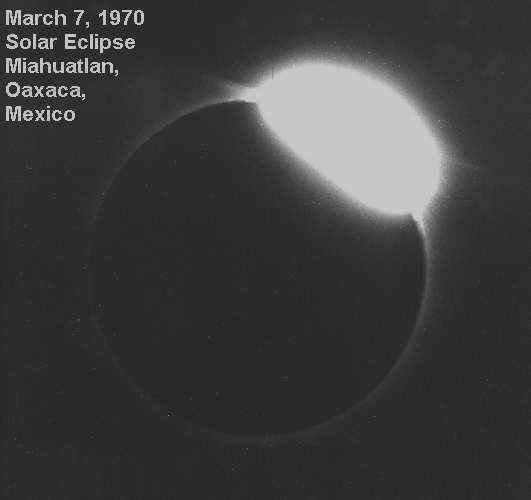
Image du Jours -- The Long & The Short
Next Long & Short Image du Jour
About this Long & Short -- #3 of 5.

Diamond Ring (K. Cashion)
In March of 1970, there was a solar eclipse under particularly good conditions.
o It would be within easy driving distance of the US.
o In an area of southern Mexico with no industry.
o There were accessible mountains on which to set up sensors.
o There would be dry, stable air away from a coast.
o It would occur near noon so there would be the least atmosphere between sensor and sun.
o And totality, that period of maximum obscuration by the moon, would last nearly three minutes.
I devised an experiment, got it approved and funded, designed the telescope, and had the parts built on-site at NASA-Houston. I assembled it (making many parts myself), calibrated it, transported it to Mexico with others of our NASA group's experiments, and I operated it during the eclipse. On return, I got the film processed in NASA's controlled photo lab and I did the analysis on the imagery -- then I wrote the technical paper.
However, the image shown is not one of those scientific images.
The image is through that scope and on the scientific film but it is one of the cute images that everyone tries to get just before totality; which is when the main photography begins. Just for a moment, as a bit of the sun is peeking from around the edge of the moon, the irregularities in the lunar horizon cause this diamond ring effect.
There is little scientific merit in the image -- it is just pretty and spectacular to observe.
The sun's atmosphere, or corona, extends many miles into space. During the day, because of the disc's brilliance, our bright sky prevents this slightly illuminated corona to be seen.
It is possible to create an artificial eclipse internal to a telescope by installing a suspended disc, or occulter, to obscure just the solar disc. Then the corona can be seen a little farther from the sun but eventually the corona becomes too dim to be seen through earth's illuminated atmosphere, so that limits the observation distance of the corona as it gets further from the sun.
During a total eclipse, however, the atmosphere is dark. Now, the corona can be seen well away from the sun. But this distance away from the sun is limited by the length of time the sun is obscured. It might be too short a time for the long exposures necessary to integrate the return energy from the far corona.
There is yet another way to observe the corona. Just before sunrise, the corona can be seen as a brighter, pointed area in the night sky. This will be from just above the horizon down to the yet-risen sun. However, this cannot be viewed for long because the sun will soon illuminate the sky and the corona will be lost from view again. This portion of the corona is part of the "zodiacal lights."
So, way out and way in, the corona can be seen from Earth; the middle area can only be seen from space. (Later, I would design a coronagraph for a Skylab orbital mission [no atmosphere] but that is another story and not part of this series.)
The telescope I designed in 1970 was to photograph just a little of the corona and make an effort to determine the solar atmospheric composition to some extent. During totality, I would photograph the corona using four polarizing filters, each preset to four axes on a filter wheel. (How it was done doesn't matter to this text.)
Some materials in the solar atmosphere/corona are subject to polarization and some are not.
The varying of film densities in coronal areas would be the ratio of polarized material with unpolarized material. There are dielectric constants that can be developed and this can translate into micrometeorite density, or population. It was this measurement that was the tie between my eclipse experiment and manned space flight. Micrometeorite strikes are a concern to spaceborne equipment...and crew.
This was an early attempt to get some idea of the particles that could penetrate space suits, chip windows of spacecraft, and actually put a hole in the spacecraft. This information would be good to have for deep-space travel in the ecliptic plane where most of this micrometeorite "dust storm" resides.
These particles are not atomic particles, as have been mentioned earlier, but are physical to the point of being 0.000002" to 0.00008" in diameter. However, as small as they may be, they are moving very fast and may be meeting a fast-moving spacecraft. One of these micrometeorites can leave a .002" diameter pit in a spacecraft window. For long missions in high-flux density environments, the window could soon become unusable. (Think about looking through sandblasted glass.)
During this time I worked in the Astronomy Branch, Space Physics Division, and we "calibrated" and scanned Apollo windows before and after flights. We mapped the windows, measured the pits, and calculated the energy and population of some micrometeorites. (I still have a piece of one of the windows.)
So now we have added another dimension involved in the "Long and Short (of it)."
The next image is unique.
Ken Cashion
Next Long & Short Image du Jour